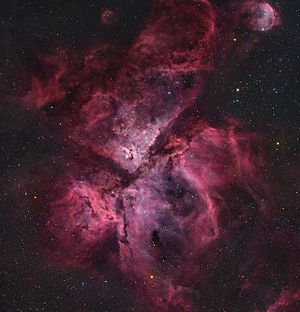Carina Nebula
| Emission nebula | |
|---|---|

The Carina Nebula. Eta Carinae and the Keyhole Nebula are just left of center, while NGC 3324 is at upper right.
Credit: Harel Boren |
|
| Observation data: J2000.0 epoch | |
| Right ascension | 10h 45m 08.5s |
| Declination | −59° 52′ 04″ |
| Distance | ~6,500-10,000 ly (~2,000-3,100 pc) |
| Apparent magnitude (V) | +1.0 |
| Constellation | Carina |
| Physical characteristics | |
| Radius | ~460 ly (~140 pc) |
| Notable features |
|
| Designations | NGC 3372,ESO 128-EN013,GC 2197, h 3295,Caldwell 92 |
Coordinates: ![]() 10h 45m 08.5s, −59° 52′ 04″
10h 45m 08.5s, −59° 52′ 04″
The Carina Nebula (catalogued as NGC 3372; also known as the Grand Nebula, Great Nebula in Carina, or Eta Carinae Nebula) is a large, complex area of bright and dark nebulosity in the constellation Carina, and is located in the Carina–Sagittarius Arm. The nebula lies at an estimated distance between 6,500 and 10,000 light-years (2,000 and 3,100 pc) from Earth.
The nebula has within its boundaries the large Carina OB1 association and several related open clusters, including numerous O-type stars and several Wolf–Rayet stars. Carina OB1 encompasses the star clusters Trumpler 14 and Trumpler 16. Trumpler 14 is one of the youngest known star clusters at half a million years old. Trumpler 16 is the home of WR 25, currently the most luminous star known in our Milky Way galaxy, together with the less luminous but more massive and famous Eta Carinae star system and the O2 supergiant HD 93129A. Trumpler 15, Collinder 228, Collinder 232, NGC 3324, and NGC 3293 are also considered members of the association. NGC 3293 is the oldest and furthest from Trumpler 14, indicating sequential and ongoing star formation.
...
Wikipedia
